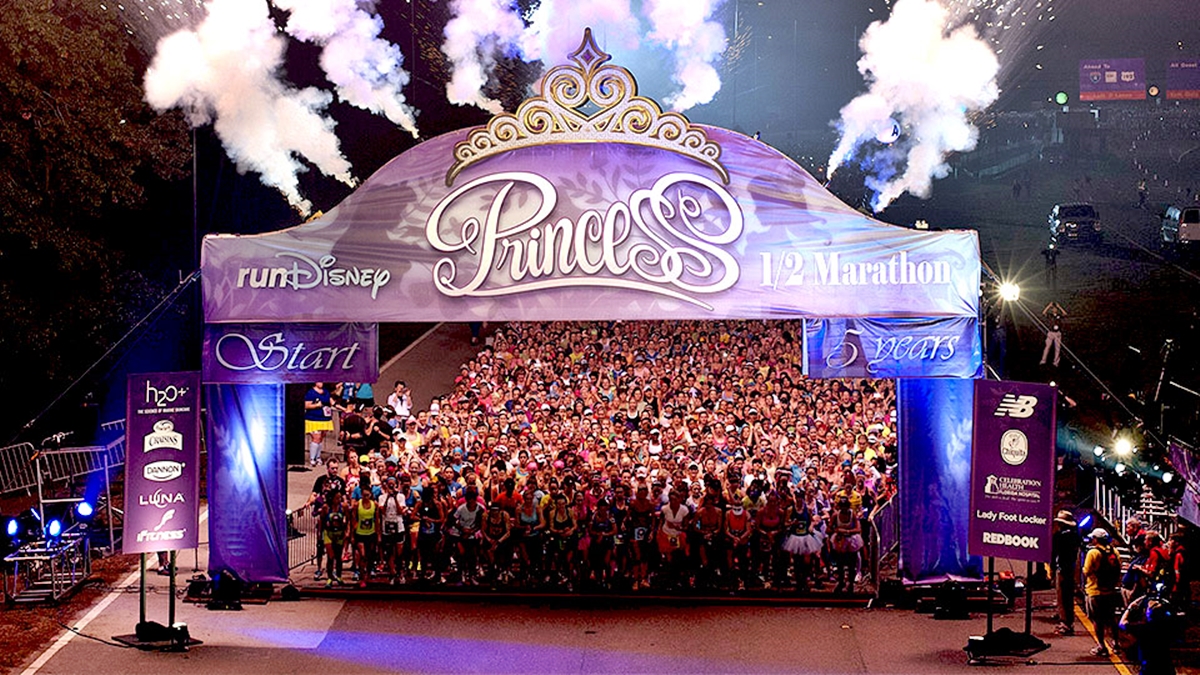

Featured
How To Train For Half Marathon
Modified: August 21, 2023
Get expert tips and guidance on how to train for a half marathon in this featured article. Start your journey to running success today!
Introduction
Welcome to the world of half marathon training! If you’ve set your sights on completing a half marathon, congratulations on taking this exciting and challenging endeavor. Training for a half marathon requires dedication, discipline, and a well-rounded approach that includes both physical and mental preparation.
Whether you’re a seasoned runner or a beginner, the key to a successful half marathon training is to create a plan that fits your fitness level, schedule, and goals. This article will guide you through the essential components of training for a half marathon, helping you develop a structured and effective training plan that will set you up for success come race day.
As you embark on your half marathon training journey, keep in mind that it’s not just about the end result, but the entire process. Training for a half marathon is an opportunity to challenge yourself, push your limits, and discover the incredible strength and resilience of your body and mind.
Throughout this article, we’ll explore various aspects of half marathon training, including setting goals, creating a training plan, building endurance, incorporating speed work, strengthening muscles, preventing injuries, nutrition and hydration, mental preparation, and race day preparation.
By the end of this guide, you’ll have a comprehensive understanding of what it takes to train for a half marathon and be equipped with the knowledge and tools to run your best race.
Setting Your Goals
Before starting any training program, it’s important to set clear and achievable goals. Your goals will provide you with direction, motivation, and a sense of purpose throughout your half marathon training journey.
When setting your goals, consider what you hope to achieve from completing a half marathon. Is it about finishing your first race and crossing the finish line? Do you want to improve your personal best time? Or perhaps you aim to challenge yourself and push your limits?
Setting both short-term and long-term goals can be beneficial. Short-term goals can help you stay focused and motivated during the training process, while long-term goals give you a bigger vision to work towards.
Make sure your goals are specific, measurable, achievable, relevant, and time-bound (SMART). For example, instead of saying, “I want to finish the half marathon,” a SMART goal would be, “I want to complete the half marathon in under two hours within six months.”
It’s important to be realistic when setting your goals. Consider your current fitness level, any previous running experience, and the time you have available for training. Setting overly ambitious goals that are not attainable can lead to frustration and burnout.
In addition to performance-based goals, it’s also important to set process-oriented goals. These are goals related to the actions and habits you’ll establish during your training. Examples include committing to a consistent training schedule, incorporating strength training into your routine, or improving your nutrition and hydration habits.
Remember, your goals are personal to you. Don’t compare yourself to others or feel pressured to meet certain expectations. Your half marathon journey is unique to you, and the most important thing is to enjoy the process and celebrate your achievements along the way.
Creating a Training Plan
Creating a well-structured and personalized training plan is essential for successfully preparing for a half marathon. A training plan will provide you with a roadmap, ensuring that you gradually and safely build your running endurance leading up to race day.
First, determine the duration of your training plan. Most plans range from 10 to 16 weeks, depending on your current fitness level and experience with running. If you’re a beginner, it’s generally recommended to allow for a longer training period to gradually build your endurance.
Next, establish the number of training days per week that fit into your schedule. Ideally, you should aim for a minimum of three to four days of running, with additional days for cross-training and rest.
When designing your training plan, include a mix of easy runs, long runs, speed work, and cross-training. Easy runs should make up the majority of your training, allowing your body to adapt and recover. Long runs help build endurance and should gradually increase in distance over time. Speed work, such as intervals or tempo runs, improves your pace and overall speed. Cross-training activities like cycling or swimming are great for aerobic conditioning and reducing the risk of overuse injuries.
It’s important to listen to your body and avoid overtraining. Include rest days in your plan to allow for recovery and prevent burnout. Respect your body’s limits and make adjustments to your plan as needed. Building gradually and incorporating recovery weeks will help prevent injuries and keep you on track.
Consider tracking your training progress using a running app or journal. This will allow you to monitor your mileage, pace, and how you feel during your runs. It can also be helpful to incorporate benchmark races or time trials throughout your training to gauge your progress and adjust your goals if necessary.
Lastly, be flexible with your training plan. Life happens, and unexpected situations may arise that require adjustments to your schedule. It’s important to be adaptable and make modifications when needed, while still staying committed to your overall training goals.
Remember, a well-planned training program is a key component of half marathon success. Take the time to design a training plan that suits your individual needs and sets you up for a strong and enjoyable race day experience.
Building Your Endurance
Building endurance is a crucial aspect of half marathon training. It allows your body to handle the increased distance and duration of the race. By gradually increasing your mileage and improving your cardiovascular fitness, you’ll be prepared to conquer the distance on race day.
One of the best ways to build endurance is through consistent and progressive long runs. Start with a comfortable distance that challenges you but doesn’t leave you completely exhausted. Aim to increase your long run distance by around 10% each week, allowing your body to adapt to the added mileage. Long runs should be done at a slower and sustainable pace, focusing on maintaining a steady rhythm rather than pushing for speed.
In addition to long runs, incorporate regular easy runs into your training routine. These runs should be at a comfortable pace that allows you to carry on a conversation. Easy runs help develop your aerobic capacity and build a solid base for your half marathon training. Gradually increase the duration of your easy runs as your fitness improves.
Don’t neglect cross-training activities. Engaging in activities such as swimming, cycling, or using an elliptical machine can boost your cardiovascular fitness while giving your running muscles a break from the impact of running. Cross-training also helps prevent overuse injuries and adds variety to your training routine.
Interval training and tempo runs are effective methods for improving endurance and increasing your running speed. Interval training involves alternating between intense efforts and recovery periods. For example, sprint for 1 minute, followed by 1 minute of slow jogging, and repeat for several sets. Tempo runs involve running at a comfortably hard pace for an extended period, such as maintaining a challenging pace for 20 minutes.
Gradually increasing your weekly mileage is another way to build endurance. Aim to increase your overall mileage by no more than 10-15% each week. Take care not to ramp up your mileage too quickly, as this can lead to overuse injuries.
Remember that building endurance takes time. Be patient and trust in the process. Consistency, gradually increasing your mileage, incorporating long runs and cross-training, and challenging yourself with interval and tempo runs will steadily improve your overall endurance as you progress through your training plan.
Incorporating Speed Work
Speed work is a vital component of half marathon training that can help improve your running efficiency, increase your pace, and boost your overall performance on race day. Incorporating speed work into your training plan will help you develop the speed and stamina needed to achieve your goals.
There are various types of speed work that you can incorporate into your training routine. One effective method is interval training, which involves alternating between periods of high-intensity running and periods of active recovery. For example, you can perform 400-meter repeats at a faster pace followed by a slow jog or walk to recover. Gradually increase the number of intervals or the distance of the repeats as your fitness improves.
Tempo runs are another form of speed work that can help improve your pace and endurance. During a tempo run, you run at a comfortably hard pace for an extended period of time. This pace should feel challenging but sustainable, allowing you to maintain a steady rhythm. Start with shorter tempo runs and gradually increase the duration as you progress in your training.
Hill training is also a valuable speed work method that helps develop strength and power. Find a hill with a moderate incline and incorporate hill repeats into your training. Run up the hill at a strong effort, focusing on maintaining good form, then recover with an easy jog or walk back down the hill. Hill training not only improves your speed and power but also builds mental toughness.
When incorporating speed work into your training plan, it’s important to allow for proper warm-up and cool-down periods. Warm up with some light jogging or dynamic stretching to gradually increase your heart rate and prepare your muscles for the intense efforts. After the speed work session, cool down with a slower jog or walk to help flush out any lactic acid build-up and prevent muscle soreness.
Be mindful of not overdoing the speed work. It’s important to find the right balance between pushing your limits and avoiding injury. Make sure to incorporate rest days and easy runs into your training week to give your body adequate time to recover.
Incorporating speed work sessions into your training plan once or twice a week can yield significant improvements in your running performance. Remember to start gradually and progress at a comfortable pace. By challenging yourself with speed work, you’ll develop the necessary speed, power, and mental resilience to tackle the demands of a half marathon.
Strengthening Your Muscles
Strengthening your muscles is a key component of half marathon training that can improve your running performance, prevent injuries, and enhance your overall fitness. Implementing a well-rounded strength training program will help you build the necessary strength and endurance to tackle the challenges of a half marathon.
Include exercises that target your lower body, core, and upper body muscles. Focus on compound exercises that engage multiple muscle groups simultaneously, such as squats, lunges, deadlifts, and push-ups. These exercises not only strengthen individual muscles but also improve coordination and stability, which are essential for efficient running form.
For your lower body, incorporate exercises that target your quadriceps, hamstrings, glutes, and calves. Squats and lunges work your quadriceps and glutes, while deadlifts target your hamstrings and glutes. Exercises like calf raises help strengthen your calf muscles, which play a crucial role in absorbing shock during running.
Core strength is essential for stability and maintaining proper running form. Include exercises like planks, Russian twists, and bicycle crunches to strengthen your abs, obliques, and lower back muscles. A strong core will help you maintain good posture, reduce the risk of injuries, and transfer power effectively during each stride.
Don’t neglect your upper body. While running primarily involves the lower body, a strong upper body can contribute to maintaining good running form throughout long distances. Include exercises like push-ups, rows, and shoulder presses to strengthen your arms, shoulders, and back.
Incorporate bodyweight exercises, free weights, resistance bands, or weight machines into your strength training routine. Seek guidance from a qualified trainer or coach to ensure proper form and technique, especially if you’re new to strength training.
When to schedule your strength training sessions will depend on your overall training plan and preferences. Some runners prefer to do strength training on the same day as their easy runs or cross-training days, while others prefer separate days dedicated solely to strength training. Experiment with different schedules to find what works best for you.
Remember that consistency is key when it comes to strength training. Aim for two to three sessions per week, gradually increasing the intensity and difficulty over time. As your muscles adapt and get stronger, consider adding variations and progression to your exercises to continually challenge yourself.
Lastly, recovery is just as important as the workouts themselves. Allow time for rest and recovery between strength training sessions, as this is when your muscles repair and grow stronger. Proper nutrition, hydration, and sleep are also crucial for muscle recovery and growth.
By incorporating regular strength training into your half marathon training, you’ll improve your overall muscular strength, endurance, and running performance. Strong muscles will enable you to maintain proper form, reduce fatigue, and power through the demands of a half marathon with greater efficiency.
Preventing Injuries
When training for a half marathon, it’s essential to prioritize injury prevention to maintain a consistent and successful training journey. Running puts stress on your muscles, bones, and joints, making injuries a potential risk. By taking proactive steps to prevent injuries, you can ensure a smooth and injury-free training period.
One of the most effective ways to prevent injuries is to gradually increase your mileage and intensity. Avoid the temptation to increase your distance or pace too quickly, as this can lead to overuse injuries. Stick to the 10% rule, which recommends increasing your mileage or intensity by no more than 10% per week. This gradual approach allows your body to adapt to the increased demands and reduces the risk of injury.
Proper warm-up and cool-down routines are crucial for injury prevention. Before each run, spend a few minutes engaging in dynamic stretches and light exercises to warm up your muscles and increase your range of motion. After your run, spend time stretching and doing gentle recovery exercises to cool down your muscles and promote proper recovery.
Listen to your body and recognize the signs of overtraining or impending injury. If you feel persistent pain, discomfort, or unusual fatigue, take a break and allow your body to rest and recover. Pushing through pain or ignoring warning signs can lead to more severe injuries that may require a longer recovery period.
Include cross-training activities in your training plan to reduce the impact on your body. Activities such as swimming, cycling, or yoga can help improve your overall fitness while giving your running muscles a break. Cross-training also helps to strengthen supporting muscles and reduce the risk of overuse injuries.
Invest in proper running shoes that provide adequate support, cushioning, and stability for your foot type and running style. Replace your shoes regularly as they wear out to maintain optimal shock absorption and reduce the risk of foot and leg injuries.
Strength training, as mentioned earlier, plays a crucial role in injury prevention. By improving muscular strength and stability, you can better support your joints and reduce the risk of common running injuries. Focus on exercises that target the muscles used in running, including the calves, hips, glutes, and core.
Prioritize proper nutrition and hydration to support your body’s recovery and reduce the risk of injuries. Maintain a well-balanced diet that includes a mix of carbohydrates, proteins, healthy fats, and plenty of fruits and vegetables. Stay hydrated throughout the day and especially during your training sessions.
Lastly, don’t forget about rest and recovery. Adequate sleep is essential for your body to repair and recharge. Incorporate rest days into your training plan to allow for full recovery and prevent burnout. Listen to your body when it needs rest and don’t hesitate to take additional rest days if necessary.
By following these injury prevention strategies, you can significantly reduce the risk of running-related injuries and maintain a consistent and enjoyable half marathon training experience. Prioritizing your health and well-being alongside your training goals will set you up for success on race day.
Nutrition and Hydration
Proper nutrition and hydration are integral components of half marathon training. Fueling your body with the right nutrients and maintaining hydration levels will optimize your performance, aid in recovery, and support overall health during your training and on race day.
As a half marathon runner, it’s important to consume a well-balanced diet that includes carbohydrates, protein, healthy fats, vitamins, and minerals. Carbohydrates are the primary source of energy for endurance activities, so aim to include complex carbohydrates like whole grains, fruits, and vegetables in your meals and snacks. Protein is necessary for muscle repair and recovery, so incorporate lean sources such as chicken, fish, beans, and tofu. Healthy fats from sources like avocados, nuts, and olive oil provide sustained energy and aid in nutrient absorption.
Before your training runs and long runs, consume a meal or snack that focuses on carbohydrates for sustained energy. Experiment with different options such as oatmeal, whole grain toast with nut butter, or a banana with yogurt. During your long runs, consider consuming easily digestible carbohydrates in the form of gels, energy bars, or sports drinks to maintain energy levels.
Hydration is crucial, both during your training runs and throughout the day. Start by hydrating well before your runs and ensure you’re properly hydrated leading up to race day. During your training, carry a water bottle or use hydration packs for runs longer than 45 minutes. Practice drinking fluids during your long runs to determine your fluid needs and tolerance.
Electrolytes, such as sodium and potassium, are essential for maintaining proper fluid balance and muscle function. Consider consuming electrolyte-rich sports drinks or adding electrolyte tabs to your water during longer runs. After your runs, replenish fluids and electrolytes to aid in recovery.
In addition to your overall diet, focus on post-run nutrition. Consume a combination of protein and carbohydrates within 30 minutes of completing your run to replenish glycogen stores and support muscle recovery. Opt for a snack or meal that includes protein and carbohydrates, such as a smoothie with protein powder, a turkey sandwich, or Greek yogurt with fruit and nuts.
It’s important to note that while specific nutrition and hydration guidelines can serve as a starting point, individual needs may vary. Experiment with different foods, fluids, and timing to discover what works best for you and your body’s unique requirements. Consider working with a sports nutritionist or registered dietitian to develop a personalized nutrition plan tailored to your goals and needs.
Remember, proper nutrition and hydration play a significant role in your half marathon training. Prioritizing fueling your body with the right nutrients and maintaining hydration levels will optimize your performance, support your body’s recovery, and enhance your overall training experience.
Mental Preparation
Mental preparation is an often overlooked yet crucial aspect of half marathon training. Your mindset and mental toughness can make a significant difference in how you approach and conquer the challenges you’ll face during your training and on race day.
First and foremost, establish a positive and confident mindset. Believe in yourself and your ability to complete the half marathon. Visualize yourself crossing the finish line and achieving your goals. Embrace a can-do attitude and cultivate self-belief as you train. Remember, running a half marathon is as much a mental feat as it is a physical one.
Practice mental strategies during your training runs to help build mental strength and endurance. Develop techniques such as positive self-talk, where you replace negative thoughts with uplifting and encouraging statements. Repeat mantras or affirmations such as “I am strong,” “I can do this,” or “I am capable.”
Utilize visualization to mentally rehearse the race. Imagine yourself going through each mile, envisioning how you’ll feel, how you’ll overcome challenges, and how you’ll maintain a strong and steady pace. Visualizing success can help reduce race day anxiety and increase your confidence.
Stay present and focus on the present moment during your runs. Don’t allow your mind to wander or become overwhelmed by the distance ahead. Break the race down into smaller, manageable segments or focus on your breathing, cadence, or form to keep your mind engaged in the present.
Set realistic and achievable goals for race day. Break them down into smaller milestones to celebrate along the way. This will give you a sense of accomplishment and motivation as you progress through the race. Remember that your main goal should be to enjoy the experience and embrace the journey.
Surround yourself with a supportive and positive community. Connect with fellow runners, join training groups, or seek out online communities where you can share your experiences, gain inspiration, and receive encouragement. Having a support system can lift your spirits, provide motivation, and remind you that you’re not alone in your training journey.
Practice stress-reducing techniques such as deep breathing exercises, meditation, or yoga to help calm your mind and manage race day nerves. Learn to recognize and control negative thoughts or self-doubt that may arise during training runs or on race day.
Stay flexible and adaptable. Understand that not every run or training session will go perfectly, and that’s okay. Focus on progress rather than perfection and be willing to adjust your training plan when necessary. Adaptability will help you navigate unexpected challenges and setbacks with resilience.
Celebrate your achievements along the way, both big and small. Recognize and appreciate the hard work and dedication you’ve put into your training. Each training session completed and milestone reached is a testament to your progress and dedication.
Remember, half marathon training is as much about mental preparation as it is about physical training. Cultivate a positive mindset, practice mental strategies, set realistic goals, and surround yourself with a supportive community. By developing mental toughness, you’ll be better equipped to conquer the challenges of training and achieve success on race day.
Race Day Preparation
Race day is the culmination of your hard work and training. Proper race day preparation will ensure that you’re physically and mentally ready to give your best performance. Here are some important considerations to make as you prepare for race day:
Start by familiarizing yourself with the race course. Review the route and elevation profile, and note any challenging sections or landmarks. Knowing what to expect will help you mentally prepare and strategize your race.
Check the weather forecast and plan your race day attire accordingly. Dress in layers if necessary and consider wearing moisture-wicking fabrics to stay comfortable throughout the race. Don’t forget to wear your well-worn and comfortable running shoes to avoid any last-minute discomfort or blisters.
Plan your race day logistics in advance. Determine the logistics for transportation, parking, and arrival time to the race venue. Arrive early to allow yourself enough time for check-in, bag drop, and warm-up activities.
Stick to your routine on race day. Eat a familiar and easily digestible breakfast that you’ve tested during your training runs. Avoid trying new foods that might upset your stomach. Hydrate well leading up to the race, but avoid over-consuming fluids right before the start to prevent needing multiple bathroom breaks.
Warm up properly before the race. Engage in dynamic stretching exercises, a light jog, or strides to gradually increase your heart rate and loosen up your muscles. This will help you be in the right physical and mental state for the start line.
Strategize your race plan based on your goals and the course. Break the race down into segments and pace yourself accordingly. Start conservatively and gradually increase your effort as the race progresses if you feel strong.
Use the aid stations strategically. Know where the water and fuel stations are located along the course and plan when you’ll take advantage of them. Practice hydrating and fueling during your long training runs to determine what works best for you.
Maintain a positive mindset throughout the race. Expect and embrace the discomfort that comes with pushing your limits. Acknowledge any negative thoughts but focus on positive affirmations and your race day goals to keep your spirits high.
Take advantage of the crowds and support. Use the energy of the spectators cheering along the course to lift your spirits and keep your motivation strong. Smile, wave, and thank the volunteers and supporters who are there to encourage you.
Push yourself in the final miles of the race. Remember that the last few miles are often the most challenging mentally and physically. Dig deep, summon your mental strength, and give it your all to finish strong.
Celebrate your accomplishment at the finish line. Take a moment to savor the moment and recognize the hard work you’ve put into your training. Collect your finisher’s medal, hydrate, refuel, and relish in the sense of achievement.
Reflect on your race experience and identify areas for improvement. What went well and what could be adjusted for future races? Celebrate your successes and learn from any challenges to continue growing as a runner.
Race day preparation is about setting yourself up for a successful and enjoyable experience. By paying attention to the details, staying focused, and embracing the journey, you’ll be ready to give your best on race day and cross that finish line with pride.
Conclusion
Congratulations on completing this comprehensive guide on training for a half marathon! By following the steps outlined in this article, you have gained valuable knowledge and insights into creating an effective training plan, building endurance, incorporating speed work, strengthening your muscles, preventing injuries, and focusing on mental preparation. You’re now well-equipped to embark on your half marathon journey.
Remember that your half marathon training is a unique and personal experience. Tailor your training plan and goals to align with your fitness level, schedule, and aspirations. Continuously listen to your body, adapt your plan as needed, and prioritize proper rest and recovery to promote long-term success and prevent injuries.
As you progress through your training, stay committed to your goals, stay focused on the process, and embrace the challenges that lie ahead. Remember that mental toughness, positive mindset, and perseverance are just as important as physical strength and endurance.
Enjoy the entire training journey, not just the race day itself. Celebrate each milestone, acknowledge your achievements, and appreciate the lessons learned along the way. Every step taken and every mile logged brings you closer to achieving your half marathon goal.
Finally, remember that participating in a half marathon is a remarkable achievement. The dedication, discipline, and determination required to complete a race of this distance are qualities that will transcend into other areas of your life. Embrace the journey, enjoy the race, and revel in the incredible sense of accomplishment as you cross that finish line.
Wishing you the best of luck on your half marathon training and race day. Stay motivated, stay focused, and most importantly, enjoy the incredible experience that awaits you!









